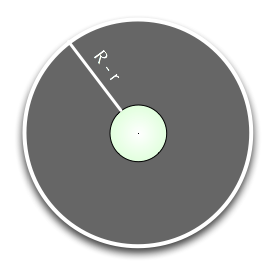Imagine a rope wrapped around the equator of the earth. For simplicity, let’s assume that the earth is perfectly spherical. Now imagine that we increase the length of that rope by 1 meter. This will create some gap between the circle made by the extended rope and the surface of the earth. Let’s say the distance (between the extended rope and the surface of the earth) is equal to L. Now repeat the same experiment with a golf ball. Let’s say the distance (between the extended rope and the surface of the golf ball) is equal to l. How different would you say L and l are?
Would you believe me if I told you that L and l are identical?
I didn’t believe this at first either. Here’s a simple mathematical proof.
The length of the original rope (before it was extended) is equal to the circumference of the object (i.e. earth or golf ball). Thus,
Length of the rope before if was extended, C = 2πr (where r is the radius of the object)
Now, we add 1 meter to the length of the original rope.
So length of the extended rope, (C + 1) = 2πR (where R is the radius of the annulus)

We’re interested in the length of the gap between the annulus and the surface of the object, i.e. R – r. (Refer to the picture on the left.)
The two formulas above can also be expressed as:
r = C / 2π, and
R = (C + 1) / 2π
Thus, R – r = {(C+1) / 2π} – {C/2π} = 1/ 2π
Which is a constant! Hence, the gap (R – r) does not depend on the size of the object under consideration. No matter how big or small the object is (be it the earth, golf ball, or the universe), the length of the gap created by an equally extended rope is always the same.
Isn’t that mind boggling?
Hat Tip and Picture Courtesy: Math~Blog.
Originally from the book Impossible?: Surprising Solutions to Counterintuitive Conundrums.